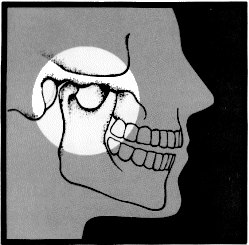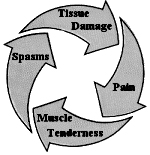TMJ SYNDROME
Thousands of patients have been diagnosed and treated for TMJ with excellent results. Others may have the syndrome, but have no idea that it can be treated.
In this page we address some of the most commonly asked questions and concerns about TMJ syndrome, as well as conservative methods of treatment. If you have further questions about diagnosis and treatment, please feel free to ask us.
What is TMJ Syndrome?
 Sixty million Americans have it. It's more common in the elderly, and affects men and women equally. Its exact cause is unknown, but women are nine times more likely than men to seek treatment for this malady.
Sixty million Americans have it. It's more common in the elderly, and affects men and women equally. Its exact cause is unknown, but women are nine times more likely than men to seek treatment for this malady.
The lower jaw (mandible) is attached to the skull by a joint on each side of the face, called the temporomandibular joint. We refer to it as the TMJ. Any number of problems associated with the chewing muscles, ligaments, bones or the joints can prevent the TMJ from functioning properly. Hence, the term TMJ syndrome.
What are the Symptoms of TMJ Syndrome?
There are many signs and symptoms of TMJ syndrome, not all necessarily present in all cases. Here are some of the most common:
- Headaches, particularly present upon awakening
- Tenderness of the jaw muscles
- Pain in or around the ear, that often spreads to the face
- Clicking, popping, or grating sounds when opening or closing the mouth
- Pain or difficulty chewing, yawning, or opening wide
- Jaws that "get stuck" or "lock"
- Earache or pain when no infection is present
- Dizziness
How can I be sure I have TMJ Syndrome?
The best way to diagnose TMJ syndrome is to rule out other possible causes of pain. Diagnosis includes a thorough oral examination, medical history and X-rays. Sometimes we also make casts (models) of your teeth, to obtain a record of your biting and chewing pattern.
What causes TMJ Syndrome?
 Disorders often result when chewing muscles and the TMJ work incorrectly. When this occurs, the muscles frequently cramp or go into spasm. Sometimes the spasms become part of a cycle that results in tissue damage, pain and muscle tenderness.
Disorders often result when chewing muscles and the TMJ work incorrectly. When this occurs, the muscles frequently cramp or go into spasm. Sometimes the spasms become part of a cycle that results in tissue damage, pain and muscle tenderness.
Accidents, including injuries to the jaw, neck, or head, or even diseases such as arthritis may cause TMJ disorders. The two most common causes of TMJ syndrome, however, are oral habits (grinding and clenching) and improper bite.
Oral Habits (Grinding and Clenching)
Sometimes patients clench their teeth together subconsciously. Or they may actually grind (gnash) their teeth. Usually at night. The term for this is bruxism. Clenching and grinding make the chewing muscles tired. That's what causes them to go into spasm. And spasms cause pain.
Improper Bite
Sometimes the teeth don't come together properly when you bite. The general term for this is "malocclusion." An improper bite may cause stress on your chewing muscles, and the TMJ syndrome prevails.

| Normal Chewing Forces |

| Abnormal Chewing Forces. |
We feel that conservative treatment is best. Because every patient is different, treatment also varies from patient to patient.
- The first step is to eliminate the muscle spasms and pain. We recommend moist heat packs applied to the face,
muscle massage and switching to a soft non-chewy diet. Sometimes mild muscle relaxant drugs and pain medication are prescribed. - Correcting the way the teeth fit together is another technique for treating TMJ syndrome. For example, if your bite is uneven, we can adjust it by selectively smoothing down the teeth that are too high. (This usually involves just one appointment and is painless). A corrective bite plate or splint will also help. Sometimes we refer TMJ patients to an orthodontist, who will prescribe and fit the necessary appliances to correct the bite.
- Counseling and relaxation therapy also help some patients with TMJ syndrome. These techniques help the patient to become aware of stressful situations; they help patients to control tension throughout various parts of their bodies. Biofeedback involves the use of an electronic monitoring device to help reduce muscle tension in the jaws.
- Surgery is the final method of treating TMJ syndrome, It may be used where muscle spasms have occurred for long
periods of time, or where the joint itself, may have become injured or arthritic. Sometimes the bones and soft tissues
of the TMJ may slip out of normal position as a result of an accident or injury, requiring surgical correction.
A final note...
Many patients have been successfully treated for TMJ syndrome, using the above techniques. The first step is bringing to our attention any signs or symptoms of TMJ irregularities you may have noticed. In many cases we can successfully and conservatively treat the symptoms associated with TMJ disorders.




